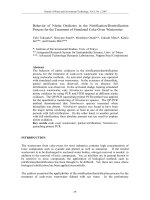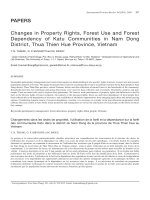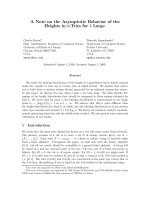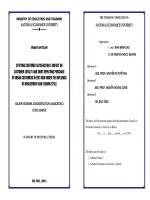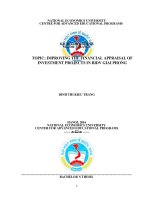BORROWING BEHAVIOR OF HOUSING CUSTOMERS IN BIDV DONG DA
Bạn đang xem bản rút gọn của tài liệu. Xem và tải ngay bản đầy đủ của tài liệu tại đây (461.28 KB, 85 trang )
NATIONAL ECONOMICS UNIVERSITY
BUSINESS SCHOOL
CAO HAI DANG
BORROWING BEHAVIOR OF HOUSING
CUSTOMERS IN BIDV DONG DA
MASTER OF BUSINESS ADMINISTRATION THESIS
HANOI – 2021
NATIONAL ECONOMICS UNIVERSITY
BUSINESS SCHOOL
CAO HAI DANG
BORROWING BEHAVIOR OF HOUSING
CUSTOMERS IN BIDV DONG DA
MASTER OF BUSINESS ADMINISTRATION THESIS
SUPERVISOR:
ASSOC. PROF. PHD TRAN THI VAN HOA
HANOI – 2021
ACKNOWLEDGEMENTS
I would like to express my special thanks to my supervisor Assoc. Prof.
PhD Tran Thi Van Hoa for his guidance and immense knowledge that
contributed to my study and helped me a lot in all the time of my study and
writing this thesis.
My gratitude to Cua Nam Transaction Department of Joint Stock
Commercial Bank for Investment and Development of Vietnam – Dong Da
Branch for allowing me to approach the respondents and providing me the
information needed for the thesis.
I would like to acknowledge the Business School for their continuous
supports and instructions during my time in this MBA program.
Finally, I am extremely grateful to family who are always giving me
encouragements, supports and advices throughout my life.
Cao Hai Dang
December 2021
TABLE OF CONTENTS
ACKNOWLEDGEMENTS
STATUTORY DECLARATION
LIST OF FIGURES
LIST OF TABLES
EXECUTIVE SUMMARY
CHAPTER 1....................................................................................................1
INTRODUCTION...........................................................................................1
1.1. Rationale...................................................................................................1
1.2. Research Objectives.................................................................................3
1.3. Research Questions..................................................................................4
1.4. Research Methodology.............................................................................4
1.4.1. Research Process.............................................................................4
1.4.2. Data collection method...................................................................4
1.4.3. Data analysis method......................................................................5
1.5. Research Scope.........................................................................................6
1.6. Structure of thesis.....................................................................................7
CHAPTER 2: THEORETICAL BACKGROUND ON BORROWING
BEHAVIOR OF HOUSING CUSTOMERS IN COMMERCIAL BANK. 8
2.1. Consumer Behavior and Consumer Decision Making Model..............8
2.1.1. Consumer Behavior.........................................................................8
2.1.2. Consumer Decision Making Model................................................9
2.2. Factors affecting decision making process of consumers...................14
2.3. Experiences in studying borrow behaviors of housing customers.....16
2.3.1. Studying of environmental influences and individual differences
factors towards borrow behaviors...........................................................16
2.3.2. Studying of factors that affecting customer decision to borrow
the housing loan.....................................................................................19
2.4. Proposed research model for analyzing borrowing behavior of
housing customers.........................................................................................21
2.4.1. General model for of decision-making for analyzing customer
borrowing behavior.................................................................................21
2.4.2. Proposed research model for analyzing customer decision of
borrowing loans.......................................................................................21
2.4.3. Measurement design for variables of the proposed research model.....24
CHAPTER 3: ANALYZING BORROWING BEHAVIOR OF HOUSING
CUSTOMERS IN BIDV DONG DA...........................................................26
3.1. Overview of Joint Stock Commercial Bank for Investment and
Development of Vietnam...............................................................................26
3.1.1. General Information......................................................................26
3.1.2. Establishment and Development History......................................26
3.1.3. Organizational Structure and Management Structure of BIDV....28
3.1.4. Main Business Activities...............................................................29
3.1.5. Financial and business performance.............................................33
3.2. Overview of BIDV Dong Da Branch.....................................................34
3.3. Analyzing borrow behavior of housing customer at BIDV Dong Da 38
3.3.1. Demographic overview of respondents.........................................38
3.3.2. Analyzing borrow behavior of housing customers in Need
recognition stage.....................................................................................39
3.3.3. Analyzing borrow behavior of housing customers in Information
search stage.............................................................................................42
3.3.4. Analyzing borrow behavior of housing customers in Evaluate
alternatives stage.....................................................................................44
3.3.5. Analyzing borrow behavior of housing customers in Decision stage...45
3.3.6. Analyzing borrow behavior of housing customers in After
purchase stage........................................................................................56
3.4. Summary of Findings.............................................................................57
CHAPTER 4..................................................................................................61
SOLUTION IN ENHANCE BORROWING DECISION OF HOUSING
CUSTOMERS IN BIDV DONG DA...........................................................61
4.1. Solution to identity more customers.....................................................61
4.2. Solution to increase competitiveness by price......................................62
4.3. Solutions to increase service qualities...................................................62
4.4. Solution to improve procedures and policies.......................................63
4.5. Limitation & further research direction..............................................64
REFERENCES
APPENDIX
STATUTORY DECLARATION
I herewith formally declare that I myself have written the submitted
Master’s Thesis independently. I did not use any outside support except for
the quoted literature and other sources mentioned at the end of this paper.
Hanoi,
/
/2021
LIST OF TABLES
Table 1: Measurement design applied in this research....................................24
Table 2: Funds mobilized as of December 31, 2020.......................................30
Table 3: Outstanding loans by term in the period of 2018-2020.....................31
Table 4: Results of foreign exchange business in the period of 2018 – 2020. 32
Table 5: Results of BIDV's international payment activities in the period of
2018-2020.......................................................................................33
Table 6: Some key business performance indicators 2019-2020....................33
Table 7: Details of financial indicators in 2018-2020.....................................34
Table 8: Respondents Demographic Profile....................................................38
Table 9: Average values of independent variables..........................................45
LIST OF FIGURES
Figure 1: The five stages of traditional consumer decision-making model....12
Figure 2: BIDV Organizational Structure.......................................................28
Figure 3: Organizational structure of Dong Da Branch..................................35
Figure 4: Net income of Dong Da Branch from 2018 to 2020.......................36
Figure 5: Dong Da Branch Housing Loan scale and efficiency......................37
EXECUTIVE SUMMARY
Researching customer behavior is a topic of recent research interest.
From the perspective of managers, bank salespeople, the study of customer
behavior helps banks easily access and increase the influence of their
products. Sharing the same view, the main purpose of this research is to
investigate the borrowing behavior of individual customers in housing loan.
In the research a conceptual model was proposed after an extensive
review of the literature. Data was collected from 156 individual customers of
Joint Stock Commercial Bank for Investment and Development of Vietnam Dong Da Branch. Descriptive statistics and Logistic Regression were applied
to analyze and confirm the conceptual model proposed in this research.
The research finds the decision-making process of customers when
choosing a loan is a complex process but can be modeled through 5 steps:
need recognition, information search, alternative evaluation, purchase
decision, post-decision evaluation. Furthermore, borrow interest and cost,
service quality and bank policies are the factor affecting the decision to
borrow the housing loan at BIDV Dong Da.
The research can be used for a reference aim and reliability suggestions
to enhance the decision of borrowing the loan at BIDV Dong Da. The
researcher also gives out some recommendations including (i) increase
competitiveness by price; (ii) enhance service qualities; (iii) reduce and
simplify bank policies; and (iv) apply marketing project.
1
CHAPTER 1
INTRODUCTION
1.1.
Rationale
Commercial banks' lending activities play an important role in the
economy. Banks act as an intermediary organization to circulate financial
resources between economic sectors, helping individuals and businesses
access financial resources to serve their consumption or production needs at
reasonable costs. In the field of personal loans, specifically housing loans,
bank loans make it easier for individuals to own an essential asset in life but
of great value, which is House.
Currently, most banks in Vietnam provide housing loan products for
individual customers. According to the statistical data about credit trends of
credit institutions in June 2021, conducted by the Department of Forecasting
and Statistics - SBV, credit institutions assess the credit needs of individual
customers in 2021 will recover strongly compared to the period of 2020,
forecast to be equivalent to the period of 2018-2019.
Banking experts said that it is understandable that banks "prefer"
personal loans in the post-Covid-19 period, because this is a loan product with
a good profit margin, high demand. People buy cars, buy houses, repair
houses are still quite large. Although it belongs to the consumer credit
segment, personal loan, especially housing loan is quite safe because it has
valuable collateral and high liquidity. In fact, not only is there a lot of room
left, but housing loans also help banks improve their profit margin (NIM),
which has fallen dramatically since the beginning of the year, thereby
improving profits.
2
Banks also expect to benefit from the Government's economic stimulus
policy. Recently, the Ministry of Construction proposed to the Prime Minister
a credit package of VND 65,000 billion to support the implementation of
social housing policies in the Sustainable Economic Recovery Program until
2023; in which, pay special attention to housing for workers and workers in
industrial parks and export processing zones. During the 4th COVID-19
outbreak, the housing area for workers was the most affected by the pandemic
due to the large concentration of workers. Therefore, investing in housing
development for industrial park workers, ensuring environmental sanitation
and health conditions for workers is an urgent solution to restore production
and economy. When the credit package is deployed, banks will certainly have
more opportunities to approach new projects and borrowers.
Thus, it can be recognized that housing loan products for individual
customers are an important product that contributes to the business results of
credit institutions. Credit institutions now increasingly research, develop and
promote housing credit products in order to increase competitiveness and
attract more individual customers to borrow money. On the side of
commercial banks, personal home loan customers are an important source of
customers, bringing relatively good profits because the loans often have long
terms, in addition, banks can cross-sell many products and services.
Therefore, competition in this lending market is also quite fierce. In Vietnam,
there are currently more than 20 domestic and foreign banks providing
housing loan products for individual customers. Customers have a relatively
wide choice of lending banks to consider, so the criteria and behavior of
customers when choosing a bank become very important for the bank's
managers when setting strategies. business. Many banks have also begun to
identify the behaviors and characteristics of customers when choosing a home
loan, and at the same time try to discover the factors that most influence that
choice.
The Joint Stock Commercial Bank for Investment and Development of
3
Vietnam (BIDV), with a vision to 2030 to become the leading financial
institution in Southeast Asia, identifies customers as one core of development,
in which Customers are the focus of all activities, understand customer needs,
on that basis provide products and services that bring maximum satisfaction
to customers. To maintain its leading position in the housing lending segment
for individual customers, in the context of increasing competition from other
banks, in addition to improving service quality and diversifying products,
BIDV and its branches also need to understand the behavior of customers
when taking out loans, thereby getting solutions to develop targeted
customers.
Borrowing behavior is also considered a purchase behavior of
customers. In fact, there have been many studies on buying behavior, factors
affecting the buying decision process of customers using customer behavior
theory, or the 5-step model of buying behavior. However, there have not been
many studies on customer behavior focusing on individual customers who
borrow housing loans. Right at BIDV Dong Da branch, there has not been any
research on the behavior of individual customers to buy a home. Therefore,
we need to find out the borrowing behavior of housing customers in BIDV
Dong Da, from there, it is expected to provide some solutions and
recommendations to help the Branch develop more customers to use loan
products for housing needs.
1.2.
Research Objectives
- To learn the process of making a loan decision of housing customers
at BIDV Dong Da
- To analyze the borrow behavior of housing customers at BIDV Dong
Da
- To propose recommendations to enhance customer loyalty of BIDV
4
Dong Da
1.3. Research Questions
- What are the steps of making decisions which housing customers at
BIDV Dong Da often follow?
- What are the factors that influence most to each steps making
borrow decision of housing customers at BIDV Dong Da?
- Which recommendations should be made to enhance the decision of
borrow a housing loan at BIDV Dong Da?
1.4. Research Methodology
1.4.1. Research Process
This research is conducted following the process as below:
Id e n tify
R e v ie w th e C o lle c t & S u m m a ry a n d
R e se a rc h
L ite ra tu re A n a ly z e
R e c o m m e d a tio
Research Problem: The
P r o b - l e Identify
m
D a t need
a of research
n on borrowing
behavior, focus on housing customer at BIDV Dong Da
- Review the Literature: Find out what has already explored in
previous research and making research model on borrowing behavior
- Collect & Analyze Data: Evaluating current borrowing behavior of
housing customer at BIDV Dong Da
- Summary and Recommendation: Reveal of findings and suggest
solutions to enhance house borrowing decision at BIDV Dong Da
1.4.2. Data collection method
a) Sample
The target sample is BIDV Dong Da’s individual customers who have
had housing loan. They have been using loan products, so they are suitable
subjects to study the process of developing loan behavior. In this research, the
data cover the customer information who has borrowed home loan in BIDV,
from 2018 to 2020
5
b) Sample size
The sample size is at least 150 respondents in order to get the result
more reliable for this research. One survey is conducted to collect information
from all customers living and working in Hanoi, who have had a housing loan
in BIDV Dong Da and who had applied for housing loan but has not
borrowed. The survey conduct time are from 2021 November to 2021
December. For 200 questionnaires giving out, there are 156 complete
questionnaires was collected and be usable.
1.4.3. Data analysis method
After valid questionnaires were collected, the raw data will be refining
and include to an Excel spreadsheet. For evaluating customer behavior at five
stages: Problem Recognition, Information Search, Alternative Evaluation,
Selection & Purchase and Post-Purchase, descriptive statistics is used to
summarize and present numerical information
For finding factors affecting Selection & Purchase stage, 4 Independent
variables Cost, Policies, Qualities, Marketing are measured by a set of
observed variables. In which Cost (C) is measured by 4 observed variables
(C1, C2, C3, C4); Policies (P) are measured by 4 observed variables (P1, P2,
P3, P4); Qualities (Q) is measured with 4 observed variables (Q1, Q2, Q3,
Q4) and Marketing (M) is measured with 3 observed variables (M1, M2, M3).
The testing methods to measure the reliability of the model are:
- Cronbach’s Alpha test: when using the Likert scale, to check the
reliability of the observed variables in the model and the reliability of the
scale, the Cronbach's Alpha coefficient should be measured. If Cronbach’s
Alpha value is higher than 0.6 then variable suited to use, else it is necessary
6
to consider removing that observed variable from the model.
- The exploratory factor analysis method (EFA) examines the
relationship between observed variables in all different groups (factors) in
order to detect observed variables that are loaded with multiple factors or
observed variables that are suppressed. In the EFA analysis method, the
criteria of interest are KMO coefficient, Bartlett test, Factor Loading.
- Building Regression model: When estimating a customer's decision
to borrow a loan, there are only two possibilities: the choice to borrow or not
to borrow, so the dependent variable The decision to borrow has 2 values: (1)
Loan decision and (0) Deciding not to take out a loan. The value of the
independent variables will affect the probability of events (1) and (0). To
measure the event probability of the dependent variable, we need to use a
Binary Logistic Regression model as bellow:
P: probability of event happening (Y = 1)
Y: dependent variable represents loan decision (Yes/No)
C, P, Q, M: individual variables represent factors affecting loan decision
B0: Constant
Βi (I = 1…4): Coefficient
1.5.
Research Scope
This research was conducted from November to December in 2021, in
Dong Da District, Hanoi City. It focuses on determining the borrowing
behavior of housing customers in BIDV Dong Da, who is individual
customers, most of them living and working around Hanoi area.
1.6.
Structure of thesis
7
This research is structured and organized in four chapters as follows:
- Chapter 1. Introduction: Introducing the thesis topic and a brief
background about it, and then following by problem statement, research
objectives, research questions, research methodology, research scope, and
finally structure of thesis.
- Chapter 2. Theoretical background on borrowing behavior of
housing customers in commercial banks.
- Chapter 3. Analyzing borrowing behavior of housing customers in
BIDV Dong Da.
- Chapter 4. Solution in enhance borrowing decision of housing
customers in BIDV Dong Da.
8
CHAPTER 2
THEORETICAL BACKGROUND ON BORROWING
BEHAVIOR OF HOUSING CUSTOMERS IN COMMERCIAL
BANK
2.1. Consumer Behavior and Consumer Decision Making Model
2.1.1. Consumer Behavior
Consumer Behavior and Consumer Decision Making is among the most
active research topics throughout the years. Walters (1974) defines consumer
behavior as: “the process whereby individuals decide whether, what, when,
where, how, and from whom to purchase goods and services”. Mowen (1993)
provides a different definition by explaining consumer behavior as: “the study
of the buying units and the exchange processes involved in acquiring,
consuming, and disposing of goods, services, experiences, and ideas".
Schiffman & Kanuk (1997) define consumer behavior as: "The behavior that
consumers display in searching for, purchasing, using, evaluating, and
disposing of products, services, and ideas”. Schiffman & Kanuk (1997)
elaborate on the definition by explaining that consumer behavior is, therefore,
the study of how individuals make decisions to spend their available resources
(time, money, effort) on consumption-related items. It includes the study of
what, why, when, where and how often they purchase and how they use the
purchased product. In addition, it encompasses all the behaviors that
consumers display in searching for, purchasing, using, evaluating and
disposing of products and services that they expect will satisfy their needs.
According to Schiffman & Kanuk (1997), two different types of
consumers can be distinguished, namely personal and organizational
consumers. Personal consumers purchase products and services for personal
9
or household use or as a gift to someone else. Personal consumers, therefore,
purchase for final consumption. Organizational consumers on the other hand
purchase products and services to run an organization, including profitable
and non-profitable organizations, government organizations and institutions.
A final definition of consumer behavior, by Engel, Blackwell &
Miniard (1990), states that: "those actions directly involved in obtaining,
consuming, and disposing of products and services, including the decision
processes that precede and follow these actions".
From a marketing perspective, consumer behavior most probably
became an important field of study with the development of the so-called
marketing concept. Assail (1995: 5) emphasizes the influence of the
marketing concept in marketing by stating that, according to the marketing
concept, marketers first need to define benefits sought by consumers in the
marketplace, followed by the drafting of marketing plans supporting the needs
of consumers.
The importance of understanding consumer behavior can most
probably be summarized in a simple, yet powerful, statement by Assael
(1995): "Consumers determine the sales and profits of a firm by their
purchasing decisions. As such, their motives and actions determine the
economic viability of the firm".
To be a successful seller of products and services (as can be concluded
from the statement above), organizations need to understand consumer needs
and behavior and draft their marketing strategies to incorporate such
behavioral needs of consumers.
2.1.2. Consumer Decision Making Model
Consumer decision-making models are widely used in consumer
10
behavior research and study areas to structure theory and research.
Advantages offered by models include the possibility to grasp visually what
happens as variables and circumstances change. Walters (1978) proclaimed
consumer decision-making models to “specify exact cause and effect that
relate to consumer behavior”. Engel et al (1995), Du Plessis et al (1991)
stated that models provide conceptual frames of reference that logically
indicate the interrelationship of variables for research purposes, provide the
possibility to understand different consumer decision processes and marketing
strategies and models play an important part in the establishment of theory.
Models of consumer decision-making have been developing over the
last 50 years and encompass research on various constructs borne out of the
economic and psychological fields. Nicosia (1966) is credited as the first to
provide comprehensive model of buyer behavior, attempt to show the
interrelationship between attributes of the consumer, the consumer decisionmaking process, the marketing communication of an organization and
feedback of the response of the consumer to the organization. Schiffman &
Kanuk (1987) explained the model by stating that it is interactive in design,
where the organization attempts to influence consumers through marketing
actions and the consumers in return influence the organization through their
purchase actions. However, a major limitation of the Nicosia model is that it
is from the marketer’s perspective rather than the consumer’s, with consumer
activities only very broadly defined. Engel, Blackwell & Kollat (1978)
criticize that the model never received necessary empirical support, nor has it
been revised to reflect changes.
The Howard-Sheth (1969) model of buying behavior attempts to
explain rational brand choice behavior within the constraints of incomplete
information and limited individual capacities. The model is also notable for
11
including a wide range of inputs into the process in terms of marketing
variables and social influences. The value of the Howard-Sheth model,
according to Runyon & Stewart (1987), is that the model attempts to identify
and organize major variables that may influence consumer behavior. The
model is also perceived to be dynamic in nature since it reflects the
complexity of consumer behavior in an attempt to understand it. However, the
Howard and Sheth model suffers from conceptual limitations. Evidence
suggests that consumers do not always follow the entire path of the model,
and the model is too complicated for routine purchases.
Engel, Kollat, Blackwell and Miniard had decades of work about
consumer behaviors. These authors were responsible for the evolution of the
model from 1968 to its present form. The complete model, called the EBM
model, was first released in 1995 and was a result of many revisions of
previous models. According to the EBM model, the consumer decisionmaking process is influenced and shaped by a number of factors and
determinants, categorized in three broad categories, namely individual
differences, environmental influences and psychological processes.
Consumer decision-making is depicted as multi-staged and complex
with several factors triggering problem recognition before initiating a
sequence of actions to reach an outcome of satisfaction or dissatisfaction
(Harrel, 1990; Cox, Granbois & Summers, 1983). Since the time there has
been very little research on consumer behavior, so far, the “Grand models” (or
the traditional model) of consumer decision-making is still widely used in
studying and research purposes. The Grand models refer to the elements of
the consumer decision process in terms of the traditional five step
classification, described as (1) need recognition, (2) information search, (3)
12
alternative evaluation, (4) purchase decision, (5) post-decision evaluation.
N e e d I n fo r m a tio n E v a lu a te P u r c h a s e P o s t-p u r c h a s e
R e c o g n itio S e a r c h A lte r n a tiv e s D e c is io n e v a lu a tio n
n
Figure 1: The five stages of traditional consumer decision-making model
These five common stages reflect the consumer decision process as a
logical problem-solving approach by initiating a sequence of actions to reach
an outcome.
Need Recognition: The first stage of consumer buying decision process
begins when the consumers are aware of a problem or need. When consumers
feel that there is a difference between the actual state and the desired state,
reaching a certain threshold, they will form an impulse to act towards the
object class that can satisfy their desire.
Information Search: The second stage consumers with needs will start
searching for more information. Consumers internal search into memory to
determine whether information is known enough to make a decision without
additional information searches. If there is not sufficient information
contained in memory, consumers will engage in external search. Individual
differences and environmental influences, influence external search. For
example, some consumers are cautious and unwilling to purchase products
without searching for extensive and detailed information, whereas others may
purchase products without comparing alternatives The more urgent the need,
the less initial information, the greater the value of the product to buy, the
more people are motivated to seek information.
Evaluate Alternatives: After processing all the information collected
13
through previous stage, the consumers will examine products in terms of their
attributes as compared to personal standards and specifications, defined as
evaluation criteria. Consumers view each product as a set of attributes with
different capabilities for seeking benefits and satisfying needs. The properties
that buyers are interested in varying by product type. They will pay the most
attention to the qualities that will bring them the benefits they are looking for.
Purchase Decision: At the evaluation stage, consumers have formed
preferences for the brands in the selection set. Consumers can also form the
intention to buy the most preferred brand. However, when consumers are
about to take action, unexpected situational factors can appear suddenly and
change their purchase intention, they are aware of the possible risks, uncertain
about their decision leads to anxiety when buying, they may cancel the
decision, or collect more information or positive supporting factors to
increase confidence in their decision.
Post-purchase evaluation: Post-purchase reaction is the final step in the
consumer's buying decision process. After the purchase is complete, the
customer uses the product and has reviews on the purchased product. The
level of customer satisfaction will directly affect the next purchase decision.
The satisfaction and dissatisfaction with the purchase and consumption of a
product is importance for producers and marketers, where satisfaction
provides feedback to pre-purchase alternative evaluation, assisting the
consumer with future alternative evaluation and choice, and dissatisfaction
which leads to external search for information.
The Grand models, however, have been criticized for: (1) considering a
rational approach to consumer decision-making; (2) generalizing the decisionmaking process; (3) concerns on details included in consumer decision-
14
making process; (4) and limitations as a result of a positivistic approach. It
was found that consumers frequently engaged in non-conscious behaviors that
might not be well modelled through a rational information processing
approach. Despite the fact that grand models have been always criticized by
scholars for not being applicable in many product or service decision-making
contexts, this study claims that stages suggested by grand models in
consumers decision-making process are almost the same stages in which an
individual customer often process through when borrowing a housing loan.
2.2. Factors affecting decision making process of consumers
Engel et al (1995) provided that the consumer decision-making process
is influenced and shaped by a number of factors and determinants, categorized
in two broad categories, namely individual differences and environmental
influences. The psychological processes in the model comprise the decisionprocess behavior of consumers which, together with the environmental
influences and individual differences, form an elaborated consumer behavior
and decision model.
The Individual Differences have five major categories which are:
- Consumer Resources: There are three consumers resources:
consumer uses time, money or economic resource and information reception
and processing capabilities. The consumer's perception regarding the
availability of these resources may affect the willingness to spend time and
money on products, which causes the consumer to carefully allocate these
resources due to the limited availability thereof.
- Knowledge: defined as the information stored in memory,
encompasses a wide variety of information, including the availability and
15
characteristics of products and services. A final component of knowledge is
the information contained in memory regarding the uses and requirements to
use a product. Consumers may, therefore, be aware of the uses of products,
although they are not able to actually operate them.
- Attitudes: An attitude can be defined as an overall evaluation of
alternatives, ranging from positive to negative. Attitudes are considered
important in viewing consumer behavior, since behavior is strongly
influenced by attitudes towards a given product or brand.
- Motivation and Involvement: Needs and motives defined as a
perceived difference between an ideal and the present state that is sufficient to
activate behavior, lead to energized behavior.
- Personality, Values and Lifestyle: Personality, values and lifestyle
encompass what is known as psychological research, where the emphasis is
placed on individual traits, values, beliefs and preferred behavior patterns that
combine to characterize market segments.
The Environmental Influences have five major categories which are:
- Culture: Culture from a consumer behavior perspective, implies the
values, ideas, artefacts and other meaningful symbols assisting individuals to
communicate, interpret and evaluate as members of society.
- Social Class: can be defined as divisions within society where
individuals share similar values, interests and behaviors. Social classes are
differentiated by socio-economic status differences, often leading to consumer
behavior differences.
- Personal Influences: Consumers are often influenced by people they
associate with, where they conform to the norms and expectations of others or
simply value their opinions in the buying process.
- Family: The family is often the primary decision-making unit with
different roles and functions, often resulting in simultaneous co-operation and
